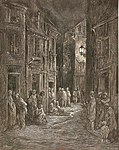St Paul's Church, Shadwell
19th-century Church of England church buildingsChurch of England church buildings in the London Borough of Tower HamletsChurches completed in 1820Commissioners' church buildingsDiocese of London ... and 5 more
Grade II* listed buildings in the London Borough of Tower HamletsGrade II* listed churches in LondonHoly Trinity Brompton plantsRebuilt churches in the United KingdomShadwell

St Paul's Church, Shadwell, is a Grade II* listed Church of England church, located between The Highway and Shadwell Basin, on the edge of Wapping, in the East End of London, England. The church has had varying fortunes over many centuries, and is now very active, having been supported recently by Holy Trinity Brompton Church.
Excerpt from the Wikipedia article St Paul's Church, Shadwell (License: CC BY-SA 3.0, Authors, Images).St Paul's Church, Shadwell
The Highway, London Shadwell
Geographical coordinates (GPS) Address Nearby Places Show on map
Geographical coordinates (GPS)
| Latitude | Longitude |
|---|---|
| N 51.509444444444 ° | E -0.0525 ° |
Address
The Highway
E1W 3BB London, Shadwell
England, United Kingdom
Open on Google Maps






